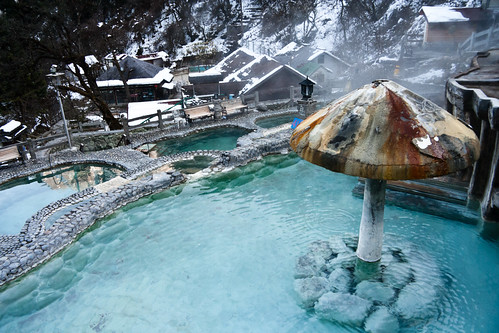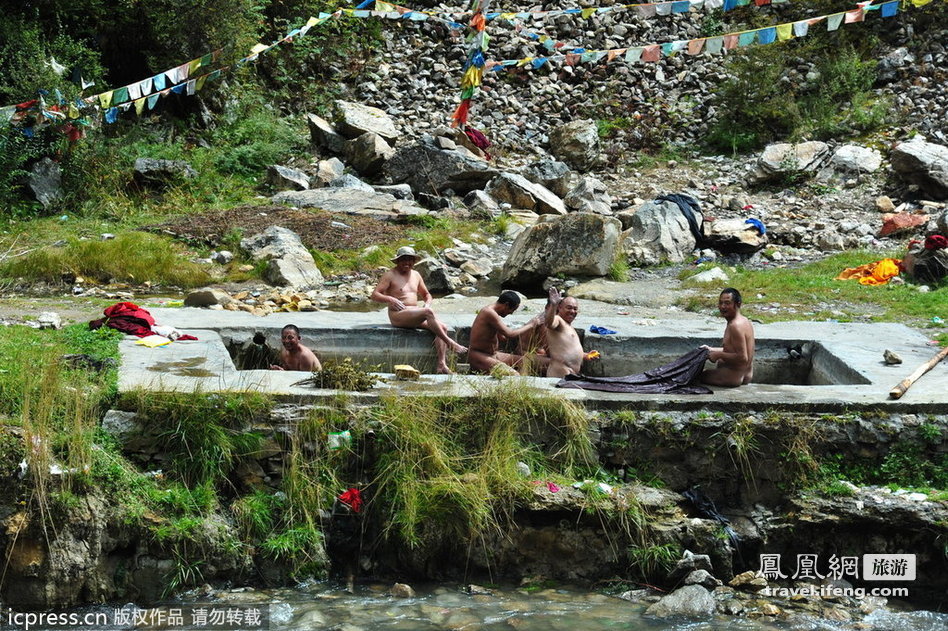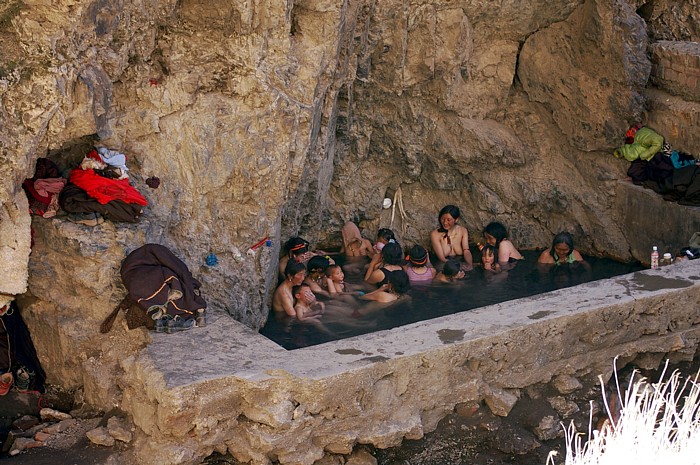Sichuan contains China's border between the lower lying areas of China proper and the mountainous entrants to the Tibetan plateau. A quick look at the map shows high mountains cut by deep valleys as the Indian sub-continent pushes further north.
In looking into the Himal hot springs of Sichuan, the autonomous prefectures of Garzê (or Ganzi) is covered in this pretty extensive section. By far the biggest prefecture of Sichuan province, Garzê was until early 20th century part of Tibetan Kham. Firmly in the mountainous terrain, the local majority Tibetans are spread over 18 counties.
Sniffing
First and foremost amongst these, is Kangding which serves as the administrative center of Garzê autonomous prefecture.
Situated 5 km from 'downtown' Kangding is the hot spring of Erdaoqiao (Erdao for short):
Other sources for info on Erdao hot springs but then in Chinese can be obtained here.
Laoyulin is also mentioned to be 5 km from Kangding and the excellent Dr Rock blog by Micheal Sydney mentions the existence of a hot spring and possibly Micheal revisits the same hot spring 4 years later:
Further away (21 km) from Kangding is the national park of Mugecuo. Wikitravel mention
Odorless
In Garzê county one can find the hot spring of Dargye which has alts in the name of Rongpatsa, Rongpaca, Rongpatsang and Yartsa. Located 25 km from the county headquarters, it is near the gompa with the same name and the village of Rongbatsa.
Daniel Winkler describes the place as follows:
Strictly
Lithang (Litang) county, to the west of Kangding contains two less well-known hot springs.
Sori hot spring is included in Daniel Winkler's hot spring overview. Then there is most probably this experience:
A little more clarified is the hot spring of Batang, 5 km west of Lithang.
Avoid
Daniel Winkler's hot spring list leads to another two soaks, Dzogchen (Zogqen) in Dêgê county and Rubu Chaka (Rubuchaka and variations in spelling of this) in Daocheng county. The former is heavily mentioned on other websites as well. The Daocheng Things to See section of Chinabackpacker mentions
Elsewhere a more recent photo shows a different more developed picture of what Daniel might have experienced.
And this hotel booking site shows that apparently the good times of cockroaches at night have passed ...
Hottest
The website of the New Long March described a trip from Zhongdian into Yunnan. As they cross into Xiangcheng county, Sichuan they come to the village of Ranwu, which has a hot spring which was
In looking into the Himal hot springs of Sichuan, the autonomous prefectures of Garzê (or Ganzi) is covered in this pretty extensive section. By far the biggest prefecture of Sichuan province, Garzê was until early 20th century part of Tibetan Kham. Firmly in the mountainous terrain, the local majority Tibetans are spread over 18 counties.
Sniffing
First and foremost amongst these, is Kangding which serves as the administrative center of Garzê autonomous prefecture.
Situated 5 km from 'downtown' Kangding is the hot spring of Erdaoqiao (Erdao for short):
'The grounds are quite expansive and encompass many different bathing areas—a great place to soak away the aches and pains of a day's hiking or horse trekking.A first hand experience:
Baths vary in temperature, from 38°C, 40°C, 42°C, up to 50°C (100 ~ 122°F) and if that's still not hot enough, there's also a sauna'.
'The first sniff of the spring had sarah imagining a bacon and egg sandwich but unfortunately the rotten egg smell of popping sulfuric gases was emitted from a pool like enclosure where our hot spring lay. All the surfaces were particularly grimy and the roof was encrusted with ice, the pool was covered by a thick layer of mist and the colour emitted was akin to the lights of a midnight dip in a swimming pool. Despite the -6 degree temperatures we smartly lowered ourselves into the hot spring and held our heads above the water. Before long Sarah noticed that my silver necklace had turned to a copper colour and rapidly changing to black. We weren't sure of the concentration of acid but sarah uses it in the workshop to blacken metal and if it touches her skin she is supposed to hop under the chemical shower'.Tripadvisor has a page on Erdao, doesn't look too appealing. But the following picture could also assist (let's hope the source correctly identified this as Erdao ....).
Other sources for info on Erdao hot springs but then in Chinese can be obtained here.
Laoyulin is also mentioned to be 5 km from Kangding and the excellent Dr Rock blog by Micheal Sydney mentions the existence of a hot spring and possibly Micheal revisits the same hot spring 4 years later:
'Just a few brick cubicles covered with cheap corrugated green plastic'.The area is becoming more of a destination for trekkers wanting to visit Sichuan's highest mountains known as Gongga (see below). An article by the China Daily gives more insight in local development combined with tourism espousing on the benefits. The 2008 article suggests a local will improve the soaking site.
Further away (21 km) from Kangding is the national park of Mugecuo. Wikitravel mention
'Dip your feet in the medicine pool (actually a hot spring) for a small fee, or have an egg boiled'.Chinatravel notes the existence of more than 20 springs and
'Boiling springs here can be categorized into many kinds, such as Buddha Spring, Clear-sighted Spring, Stomach-improving Spring, and Feet Bath Spring, etc. The water of Buddha Spring has no peculiar smell; it is good for heart and eyes if infused with tea. Clear-sighted Spring, Stomach-improving Spring, and Feet Bath Spring are respectively helpful for the treatment of eye disease, tummy bugs and rheumatism, as well as for health keeping. From ancient times till now, the spring water here is reputed as "divine Water"'.Even more hot springs are supposed to be apparent according to the blog entry by Memories on a shoestring:
'We had a light meal at a hotspring area. Apparently Mugecuo Scenic Area has nearly 100 hot springs which have different curative effects. I did not try the hotspring. It cost RMB20 to enter inside. Each of us bought an egg to eat. It is half-boiled egg for RMB3'.The blog entry comes with many photo's of the scenic area. From the photo's of the lunch break one can see that quite an effort has been made to upgrade these to afford visitors a soak if only of the podo variety ...
Odorless
In Garzê county one can find the hot spring of Dargye which has alts in the name of Rongpatsa, Rongpaca, Rongpatsang and Yartsa. Located 25 km from the county headquarters, it is near the gompa with the same name and the village of Rongbatsa.
Daniel Winkler describes the place as follows:
'Odorless hot water wells up with bubbles from the white granite sand ground. Dig in your feet and you will enjoy a bubble bath. Alas, the temperature of the pool is slightly below body temperature (35°C / 95°F). However, the clear water and the magnificent view of glaciated mountains make this spring a special treat. May be I should mention that this is the men's pool. There is also a woman section down below near sinter outcroppings'.He adds a nice picture which though the same place as below, it clearly gives a different feeling to the soak.
Strictly
Lithang (Litang) county, to the west of Kangding contains two less well-known hot springs.
Sori hot spring is included in Daniel Winkler's hot spring overview. Then there is most probably this experience:
'That was when I noticed local Tibetans in a hot spring across the river. I wandered over to check it out and found the water temperature to be just right. The extremely hot spring water had been mixed with the icy river water. There were several pools—the ones farther up the trail were strictly for womenfolk, so I stayed with the men. Tibetans don't bother with bathing suits—and neither did I—much to the amusement of my companions'.Possibly not even Sori hot spring, but nonetheless a nice description of a good soak!
A little more clarified is the hot spring of Batang, 5 km west of Lithang.
'There are a number of places to bathe there, but don't expect to be a wash in nature - the hot water is piped into white - tiled tubs'.Elsewhere this web site makes mention of many hot springs.
Avoid
Daniel Winkler's hot spring list leads to another two soaks, Dzogchen (Zogqen) in Dêgê county and Rubu Chaka (Rubuchaka and variations in spelling of this) in Daocheng county. The former is heavily mentioned on other websites as well. The Daocheng Things to See section of Chinabackpacker mentions
'It was reported [in 2003] that many cockroaches were found in the bathroom. Avoid going there during the night when cockroaches are extremely active, and can be found everywhere, even in your clothes and shoes. Believing in Buddhism, local Tibetans do not bother to eliminate them'.It's unclear whether this is advice to stay clear or the opposite.
Elsewhere a more recent photo shows a different more developed picture of what Daniel might have experienced.
And this hotel booking site shows that apparently the good times of cockroaches at night have passed ...
Hottest
The website of the New Long March described a trip from Zhongdian into Yunnan. As they cross into Xiangcheng county, Sichuan they come to the village of Ranwu, which has a hot spring which was
'developed at great expense but in very poor taste. ... The spring is only a few meters away from the pools, the smaller of which is the hottest hot spring I have ever used in China. The water was formerly monopolised by a local Living Buddha; after he had washed, the water flowed into a lower pool which the locals used'.
No. 2 is the Best'Ru Buchaca named because place names spa, Ru cloth Tibetan word for "friend", "Chaka" Tibetan is the spa, alias Charles co Wenquan Ru. Ganzi is a well-known high-temperature steam springs, hot springs at the outlet water temperature is 68 ℃, up to 80 ℃, flow rate up to 7000 m3 day and night, hot springs water is clear, colorless and odorless, contains no sulfur, drinking, with physical fitness, longevity, medicinal, regulating endocrine function, treatment of skin effect'.
In Luding county (100 km from Kangding) one can find what seems to be Sichuan's most frequented hot spring for the mountainous part of the province. Located near Sichuan's highest mountain, Gongga (Minya Konka) and in China's biggest glacier park (?), are the hot springs of Hailuogou which for the convenience of foreigners has been (re?) named Conch Gully.
 Hailuoguo's no. 2 (source: RichardLuyy)
Hailuoguo's no. 2 (source: RichardLuyy)Hailuoguo even makes it to the top 10 hot spring resorts of China (source).
Despite all the claims to it's naturalness the springs themselves are part of a tourism set up such as the Gongga God Hot Spring Hotel. In total there are 3 hot springs in Hailuogou according to the article entitled 'Attractions: Four unique hot springs in China', one of them being Hailuogou.
That said it are so-called camps at hot springs 1 and 2 that attract most visitors. Sabrina while blatantly copying on her blog copies:
'... most of the visitors favor hot springs in No.2 Campsite because they are rustic, with more natural taste'.In this article discussing 'green' tourism in Ghanzi prefecture, the park around Hailuoguo is mentioned a number of times for the lack of 'green' planning.
'Several hot-spring resorts inside the park have tacky buildings and decorations totally alien to their setting. "These are truly ugly to me," Hitesh Mehta, a Canadian landscape architect, said in his presentation."They are beautiful," he said, pointing to the photos of traditional wood houses seen at Moxi Town just outside the park. "Unfortunately there are not many left."
Facing the criticism, Xiao Feng, director of the administration of the park, explained that these problems were mainly caused by several independent tourism operators inside the park and their bad management. At present, the administration is purchasing their property back to solve these problems.
However, many conference participants expressed doubts as to the local authorities' humble attitudes towards investors from the outside world.
"They spoil investors for sure," Chen Xujun said. "Most of them become indifferent to the local environment and welfare of the local communities."'
Then there is this info:
'According some doctors, the boiled water has high medicinal values, such as curing skin disease and arthiritis, and eliminating fatigue'.
Fire
Another county in Garzê with geothermal features is that of Danba. Also known as Rongzhan, the main place to visit for these features is the mountainous area of Dangling. Chinabackpacker:
'The hot-springs in Dangling are located in two areas, one at Benmu which is the rich in sulphur, and means 'fire bath' in Tibetan. The other site is at Kabu, encirlced by grassland which in Tibetan translates as 'grassland bath'. The two springs are approxiamately 4 kilometres south of the Dangling village, and the water flow never cease all year round, day and night the liquid output amouts to about 3000 tonnes. The water close to the hotspring mouth can reach up to 75 degrees Celcius. Chemical tests show that the springa belong to the type neutral, heavy sodium carbonic acid with healing properties. It contains many minerals that are epecially beneficial to the likes of headaches, stomach and intestinal diseases, diabeties, arthiritis. Surrounding the hot-springs is a picturesque primeval forest, sitting in the hot-spring bath, washing away the weariness from the travelling, indulging in the most that the hot-spring can offer. And when it's winter, the enjoyment only gets better as you take the pleasure of bathing in open snow: indulge in the winter scenery while bathing in the warm spring water, and if you are lucky enough and it snows, you can slowly relish yourself with the spectacle as snow flower fill the sky while you let your body relax in the warm bathe'.
Source Translated with google, you make sense:
'September 22, 2012, known as the "natural bonsai" Yak Valley Scenic Area is located 21km southwest of the county, Ganzi Tibetan Autonomous Prefecture in Danba East Valley township, road side there is a very famous natural hot spring baths, but also the rare nude bath one place'.
And though it looks idyllic there are always qualms. Timemaker:
The first stop was a natural hot spring by the road. The hot steam was perfect for warming my frozen hands. I didn’t want to soak in the water though; I read that sick locals like to visit hot springs. It was especially uninviting when the driver told me you can cure STDs by soaking in the hot spring for a week'.
It probably reflects more on the writer as especially in Chinese there are many good references.
It is well and truly Tibetan country here so you'll see complete encampments during season of locals enjoying these springs.
It is well and truly Tibetan country here so you'll see complete encampments during season of locals enjoying these springs.
Note that if I am correct just behind the hot spring pictured a road has been laid ... Drates. A paradise lost?













